Latest Gartner Hype Cycles
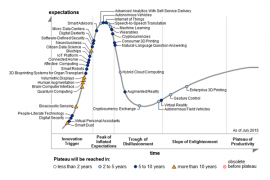
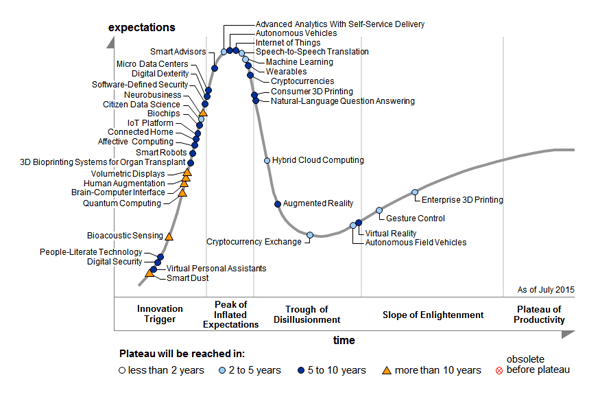
Evaluating technology options for innovation in marketing – do you know your hype cycles?
If you’re involved in marketing strategy development, you will be constantly making judgements and doubtless arguing with colleagues about which digital technology innovations are most relevant to your organisation. In this post. we compare different examples of Gartner’s well established Hype Cycle tools which serve to highlight the adoption of new technology tools within marketing technology.
You’ll see we have updated the post for different years, so you can see how technology trends have changed.
The Gartner Hype Cycle model for technology innovation
You may well know the Gartner Technology Hype cycle since this has been published for over 10 years, over time they have added a comprehensive range of hype cycles covering technology applications like Ecommerce, CRM and ERP. Many of these are only available to subscribers, but Gartner do share some of the broader hype cycles through their blog/press releases and we share them here to raise awareness of these useful tools.
2015 Gartner Hype Cycles for technology and marketing
Gartner announced their new The 2015 Hype Cycle report identified 5 mega-trends which will play out over the next few years. These were:
- 1: Digital Business Moves Toward the Peak of Inflated Expectations
- 2: IoT, Mobility and Smart Machines Rapidly Approach the Peak
- 3: Digital Marketing and Digital Workplace Quickly Move Up
- 4: Analytics Are at the Peak
- 5: Big Data and Cloud Make Big Moves Toward the Trough of Disillusionment
Let’s see how these compare to the 3 mega-trends predicted by 2014’s report:
- Brain Computer interface
- Virtual Reality
- Virtual Personal Assistants and Smart Advisors
Brain-computer interfaces still seem a while away for most of us, but there has been big strides in the interfaces, especially for controlling robotic limbs for people who have lost their legs or arms. VR was also a big trend of 2015, as was virtual personal assistants, with Facebook launching ‘M’ in beta, and Siri, Google now and Cortana all battleing for market share.
The Digital Marketing hype cycle for 2015
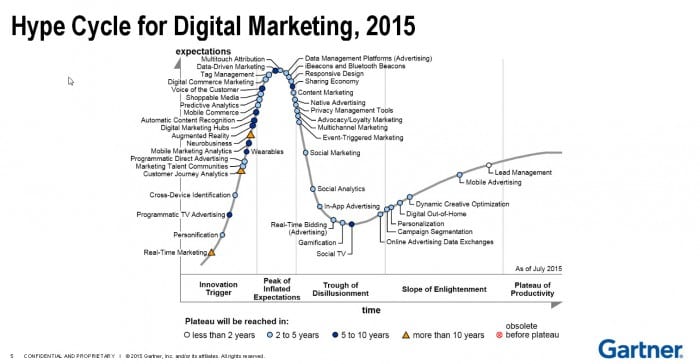
Gartner’s hype cycle for digital marketing is particularly useful for Smart Insights readers. This year’s report showcases some really interesting trends. Wearables is currently ascending the peak of inflated expectations, and with all the hype around them they could have quite a long fall into the trough of disillusionment. Mobile advertising is now headed straight for the plateau of productivity, which is where it will rightfully sit given most web traffic now comes from mobile. Watch out for real-time marketing and personification to be key trends emerging in 2016, and integrate them into your marketing plans where possible.
The Digital marketing Hype cycle for 2014
The emerging technologies trend report is the best known Gartner hype cycle, but is in fact, one of many hype cycles covering activities from Big Data to Ecommerce. Also, this year Gartner have released this report specifically on Digital Marketing which will be of particular interest to Smart Insights readers.
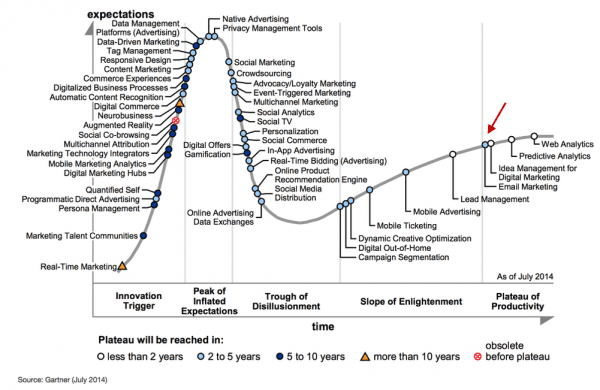
Lot’s of discussion points on the latest Digital Marketing hype cycle! I usually start by reviewing the newer technologies on the left, but here it’s interesting to see what has reached the “Plateau of Productivity”. I’d agree that Email marketing and lead gen should be here, but where is Search Marketing?! I’d disagree that Predictive Analytics is widely adopted, only in the largest organisations, I’d say. Even with web analytics, my experience is that it’s installed, but poorly configured and underused in many organisations – we’re launching an #ActionableAnalytics campaign and dashboard shortly to help businesses focus on this.
Working back to what is slipping into the aptly named “trough of disillusionment”,it’s no surprise to see RTB and some aspects of social media marketing languishing there. I’d disagree that website personalisation, Event-triggered marketing and multichannel marketing are heading into the trough, these are certainly on the Plateau of productivity for many businesses, particularly retailers, banks and travel companies.
Moving further left to the emerging technologies, many of these have been around for years, content marketing, data drive marketing, customer experience management, digital commerce, personas and tag management will all be super-familiar to Smart Insights readers, but Gartner do focus more on the IT management audience. Even Realtime marketing can’t be considered new…
Gartner Hype Cycles for technology and marketing in 2013
For reference and comparison to previous years., we have included the Gartner technology maturity adoption curves from previous years. In July 2013 Gartner released their Digital Marketing Hype Cycle – you can see some interesting commentary in this Slideshare kindly recommended by Jon Clements in the comments to this post and we added this in December since it’s sure to be of interest to Smart Insights readers. We cover many of these in our 2014 digital marketing trends post. Digital marketing specialists may be surprised to see some established techniques such as content marketing, attribution, responsive design and mobile analytics only at the innovation trigger stage although some of these are reaching the peak of the hype cycle.
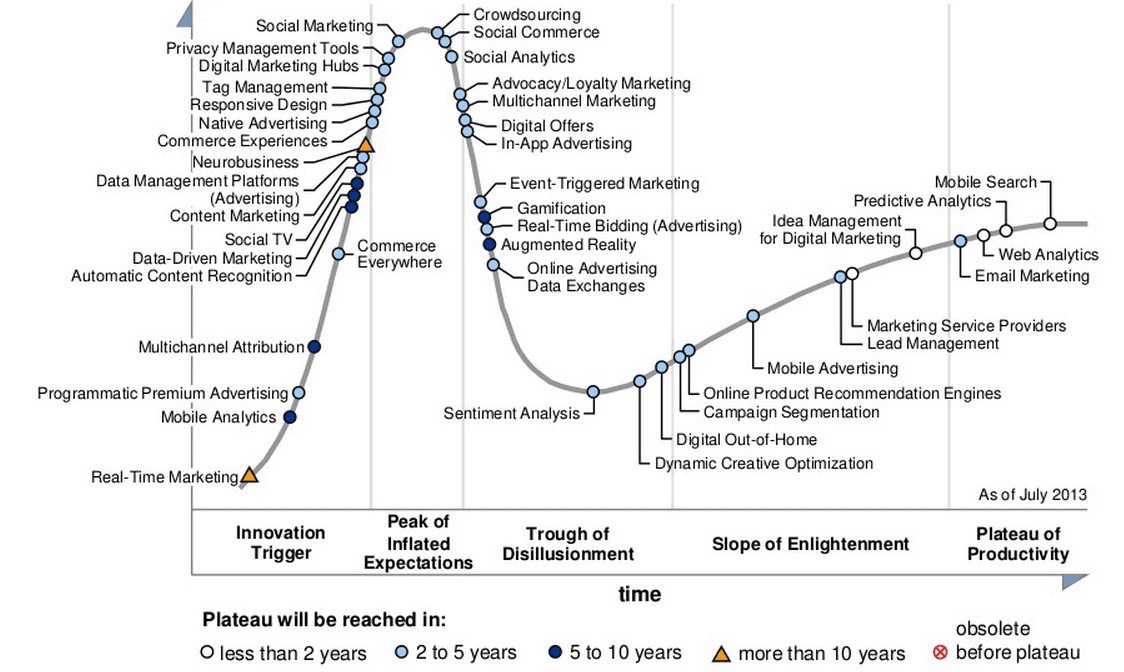
In August 2013, Gartner followed with their Latest 2013 Hype Cycle of emerging technologies. If you don’t know it, this is one of the best ways to find out about the upcoming technologies which may affect digital marketing.
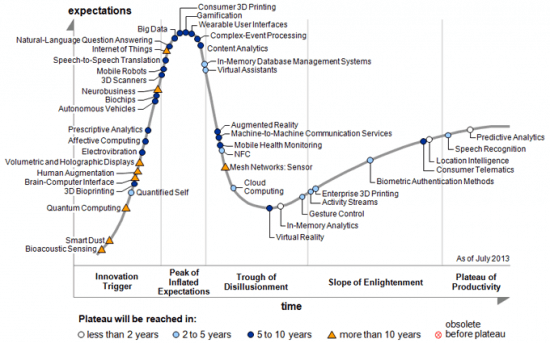
Marketers who follow new technology will not be surprised to see Big Data nearing the Peak of Inflated Expectations along with wearable technology. Scary-sounding new technologies to watch include the Brain-computer interface, Human Augmentation and Neurobusiness.
For reference we also have the 2010 and 2009 models from when I first wrote this post. It’s interesting that those rising up the “peak of inflated expectations” currently those looking most relevant for marketing are Video search, Augmented Reality, IP TV are not mainstream still, probably consigned to the “Trough of Disillusionment”.
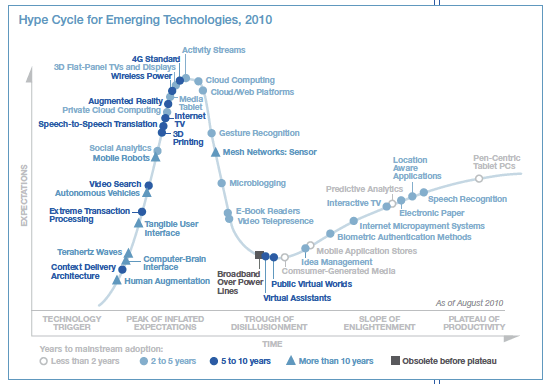
Gartner Hype Cycle 2009
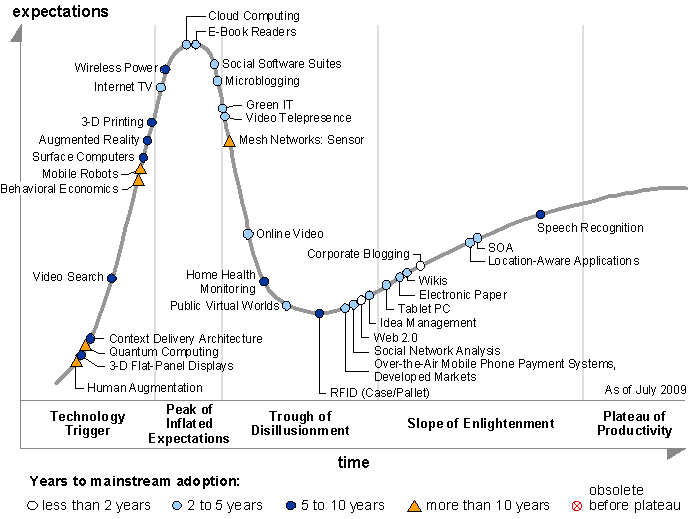
Here is my summary of the 5 stages of diffusion of innovation used by Gartner – it can be useful for explaining to colleagues your strategy when you have adopted a “wait and see” approach because you don’t want to waste time implementing a solution that never gets out of the “trough of disillusionment”. Alternately, in digital marketing, many smaller, nimble companies have gained an edge amongst early adopters of an approach such as social media or Web 2.0.
1 Technology Trigger – The first phase of a hype cycle is the “technology trigger” or breakthrough, product launch or other event that generates significant press and interest.
2 Peak of Inflated Expectations – In the next phase, a frenzy of publicity typically generates over-enthusiasm and unrealistic expectations. There may be some successful applications of a technology, but there are typically more failures.
3 Trough of Disillusionment – Technologies enter the “trough of disillusionment” because they fail to meet expectations and quickly become unfashionable. Consequently, the press usually abandons the topic and the technology.
4 Slope of Enlightenment – Although the press may have stopped covering the technology, some businesses continue through the “slope of enlightenment” and experiment to understand the benefits and practical application of the technology.
5 Plateau of Productivity – A technology reaches the “plateau of productivity” as the benefits of it become widely demonstrated and accepted. The technology becomes increasingly stable and evolves in second and third generations. The final height of the plateau varies according to whether the technology is broadly applicable or benefits only a niche market.
Selecting alternatives for marketing innovation
Selecting amongst hundreds of alternative projects is a challenge I commonly hear when talking to digital strategists. One approach I have developed when consulting, to help with this, is the matrix below which we describe along with other alternatives in our guide and template to justifying digital marketing investments. Of course this structured approach won’t fit the culture of all organisations, but even a simple unscored version of this is useful within a workshops to help discuss the relative merits of different digital projects.
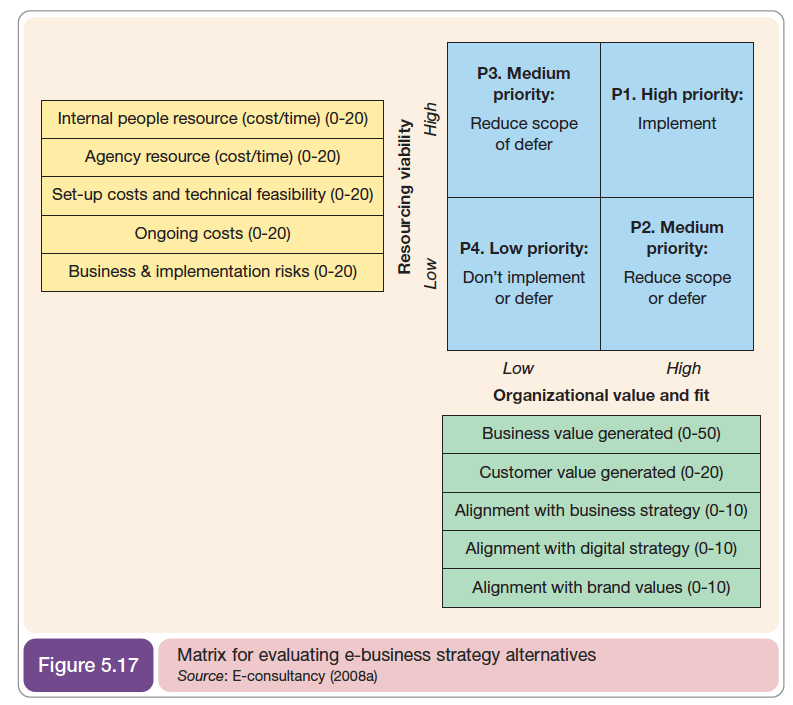
Forrester produced a “HERO” Project Effort-Value Evaluation tool which works in a similar way.
From our sponsors: Latest Gartner Hype Cycles



